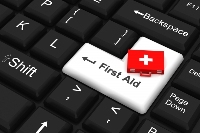
Surfacing from the catastrophe of last weekend (you can read about it in my previous post Computer Blues) when our web host’s server crashed beyond repair, I’ve had a chance to reflect on some of the lessons I learned from the experience.
They may hold a few gems you’ll find superbly useful. Perhaps you’ll simply laugh at my naivété and muddled approach. Or you may even be horrified, to think anybody managing websites could be so unprepared for a crash of such major proportions.
But whether they make you goggle, giggle or groan, I hope you’ll enjoy reading them.
Oh … and if I’d learned the first lesson properly before this, I probably wouldn’t have learned most (though not all) of the others. I wouldn’t have needed to! ;)
1. Back up, back up, back up ..
Ok, I know this one should be obvious .. But even if you are meticulously backing up your database and website files regularly, be sure to do so again immediately after making any significant changes or updates. As I found out last weekend, even if you finish work on your site very late at night, a backup at that point is far more important than sleep! :)
One MAJOR thing I’ve learned is that relying on any one backup system may not be wise. To date, apart from our host’s backup processes, I’ve relied on WordPress database backups through CPanel (at the back end of our site) and a full FTP download of ALL files on the server.
The problem is, this is cumbersome and very time consuming – even with just 6 sites to manage and those all comparatively small. So … you, know how it goes … even with the best of intentions and plans, it doesn’t get done as often as it should.
I’ve tried a few backup plugins in the past – some wouldn’t work at all, some never finished the backup process but kept spinning their wheels, and yet others were way to complicated to figure out.
At the time of writing this, I’m exploring options again. And there are new ones on the market now. The challenge is to sift through all the affiliate marketing raves and find a few gems that are truly independent reviews. :) Stay tuned – I’ll report here later on what I can find out. And if any of you reading this have any recommendations, I’m all ears. ;)
2. Don’t rely on WordPress alone to preserve the content of pages and posts.

By all means draft and publish your copy (for either pages or posts) in the WordPress admin area. But be sure to put that copy – especially important copy – safely somewhere else as well.
What program you use to do so probably doesn’t matter much – whether it’s in simple text files or Word, or another program entirely.
But, should the worst happen, you’ll at least have the words you so carefully crafted ready to hand so you can re-create what needs to be re-created.
3. Google is your friend …
One of the helpful things for me was to type our page headers into Google and go to ‘cached pages’ . Though not for all of them, I was able to collect a screen grab and the source code for some of the pages that had been lost. That made it a relatively quick process to re-create them.
4. Use a clipboard extender

My own favourite is Clipmate – but I assume there are other programs that do the same thing. Every time you copy some text, it’s saved to the program and can be re-pasted again and again should you wish to do so. Clipmate keeps all these clips until you manually delete them – or for a particular time period you’ve specified in the preferences.
While I hadn’t had the program open for all the posts or copy I’d worked on for our sites, it had been active for some of that work. So I mined it for what was there – and found a very useful pile of bits and pieces that I could re-use or that, at the very least, provided me a skeleton on which I could re-build the flesh of what I’d written.
5. Keep a current, updated list of plugins you’ve installed and are using
Once again, while a full WordPress backup (NOT just a database backup) should keep this information intact, if that backup fails you’re back to scratch trying to remember the full list of those superbly useful plugins you’d been using. Keeping a current list means you can simply look them up again in the “Add New Plugin” search box and quickly re-install them. Again, a simple text file of their names would do the trick.
6. Keep copies of text or html and php code you’ve used in widgets
Fortunately this was something I had done for widgets we’d created. It was a simple matter to add a new text widget to the restored site that had lost it, then copy the original text or code into it.
7. Customise/edit website or plugin files on your computer and use FTP to upload them

WordPress allows you to edit CSS and PHP files within the admin area, saving the edits to your server from there. However that way the only copies of modifications you make are on the server. So if a database backup gets corrupted, you’ve lost all those changes.
Once again, I was fortunate I’d opted always to use an FTP program to download from the server any file I wanted to modify, before uploading it again. So, although I needed to do so carefully, checking after every upload that a particular file didn’t ‘break’ the site (which the host had restored the ‘old’ backup), I was able to restore/recover all the customising I’d done.
8. Take a screen grab of settings pages for plugins with complex options
This one may seem like overkill … but when you’ve made all the changes you want to the settings for a complex plugin, take a screen shot and save it as an image file to your computer. One of my favourite programs is SnagIt, and the history of screen grabs the program keeps was a boon for me in the recovery process.
Earlier, while testing some changes and plugin alternatives, I’d deactivated and uninstalled a couple with complex options screens. In case I wanted to re-install them – and I found I did – I’d taken a screen shot of the settings page in the admin area. Much quicker than having to write down all the settings somewhere. :)
So when I had to reinstall them once more after the crash, entering my preferred options again was a snap.
9. A recovery process can also bring serendipity and surprising ‘gifts’!

Ok, so when we’re in the process of recovering a website that’s died, there’s a deep mire of frustration, irritation, and even grief to wade through. But in all the work that has to be done, there can be some surprising gains as well.
For example, I found that, because I’d not kept copies of all the pages or blog posts (including some that were scheduled for the next couple of weeks) I was forced to begin the process of re-writing an number of them.
In doing so, I think I ended up with even better copy than had been there in the first place. I think so anyway. :)
And because I’d not kept a list of the plugins we were using, I had to search all over again (in some cases) for a suitable plugin to do what was needed. And in that process, I found some newer options that were even better than the ones we’d been using before.
While I’d not wish this experience on anyone – including myself – at any time, I can also appreciate there are some positives to be found in it.
10. Don’t shoot the messenger …
Although this one is very different from those above, I believe it’s equally important. Of course we all expect perfection from our hosting providers. :) And we don’t anticipate complete server failures like Aussie Host, our own hosting provider, experienced last weekend.
So when disaster strikes, frustration, impatience – and anger – are natural human responses. I witnessed some of that in the Aussie Host forum – and was very impressed, I might add, by the transparency and responsiveness of the tech team replies!
But, while it’s natural to express those very human feelings, I think it’s also important to remember the hosting provider and their tech support team are equally frustrated. And, while smooth and trouble-free operation is crucial for our own business or organisation, it’s just as crucial for theirs.
Provided they are doing all they can to rectify the problem and trying to ensure it can’t happen again, I believe we can’t ask for more.
Leave a Reply